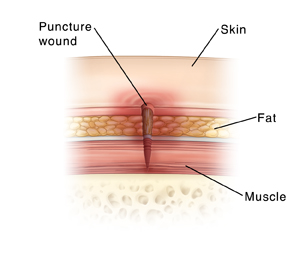A puncture wound occurs when a pointed object pushes into the skin. It may go into the tissues below the skin, including fat and muscle. This type of wound is narrow and deep and can be hard to clean. Because of this, puncture wounds are at high risk of becoming infected.
X-rays may be done to check the wound for objects stuck under the skin. You may also need a tetanus shot. This is given if you are not up-to-date on this vaccine. You may also get this shot if it's been more than 5 years since your last tetanus shot and the object that caused the wound may lead to tetanus.
Home care
-
Your healthcare provider may prescribe an antibiotic. This is to help prevent or treat an infection. Follow all instructions for taking this medicine. Take the medicine every day until it's gone or you are told to stop. You should not have any left over.
-
You can take acetaminophen or ibuprofen for pain, unless you were given a different pain medicine to use. If your healthcare provider prescribes medicines for pain, follow the instructions for taking them.
-
Your healthcare provider will likely give you instructions on how to care for the wound. Follow these instructions.
-
Keep the wound clean and dry. Don't get the wound wet until you are told it is OK to do so. If the area gets wet, gently pat it dry with a clean cloth. Replace the wet bandage with a dry one.
-
If a bandage was applied and it becomes wet or dirty, replace it. Otherwise, leave it in place for the first 24 hours.
-
You may shower as usual once your provider gives you the OK to get the wound wet. But don't soak the wound in water. This means no tub baths or swimming.
-
Even with correct treatment, a puncture wound may become infected. Check the wound daily for signs of infection listed below.
Follow-up care
Follow up with your healthcare provider as advised.
When to seek medical advice
Call your healthcare provider right away if any of these occur:
-
Signs of infection. These include:
-
Redness or swelling around the wound gets worse
-
Warmth of the wound increases
-
Pain gets worse
-
Red streaking lines away from the wound
-
Draining pus
-
-
Fever of 100.4°F (38.ºC) or higher, or as directed by your healthcare provider
-
Changes in color of the wound
-
Numbness around the wound
-
Decreased movement around the injured area


